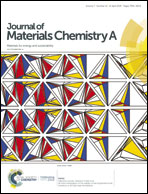Asymmetric fused-ring electron acceptor with two distinct terminal groups for efficient organic solar cells†
Abstract
Asymmetric acceptor–donor–acceptor (ADA)-type fused-ring electron acceptors (FREAs) have recently attracted increasing interest due to their excellent photovoltaic properties. However, terminal group engineering hasn't received as much attention as central core engineering does. In this work, we designed and synthesized a novel asymmetric FREA with two distinct terminal groups, namely IDTT-2F-Th, to further extend the asymmetricity along the backbone. Indacenodithieno[3,2-b]thiophene (IDTT) is end-capped with 2-(6-oxo-5,6-dihydro-4H-cyclopenta[c]thiophen-4-ylidene)malononitrile and 2-(5,6-difluoro-3-oxo-2,3-dihydro-1H-inden-1-ylidene)malononitrile terminal groups. Compared with the symmetrical ITCPTC acceptor, IDTT-2F-Th exhibits a deeper lowest unoccupied molecular orbit (LUMO) energy level, broader absorption range and relatively lower crystalline nature. By blending with the PBT1-C-2Cl donor, IDTT-2F-Th-based organic solar cells (OSCs) show a power conversion efficiency (PCE) of 12.0%, which is higher than that (10.3%) of ITCPTC-based devices. Our results demonstrate that terminal group engineering is a promising approach for developing high-performance asymmetric FREAs.



 Please wait while we load your content...
Please wait while we load your content...